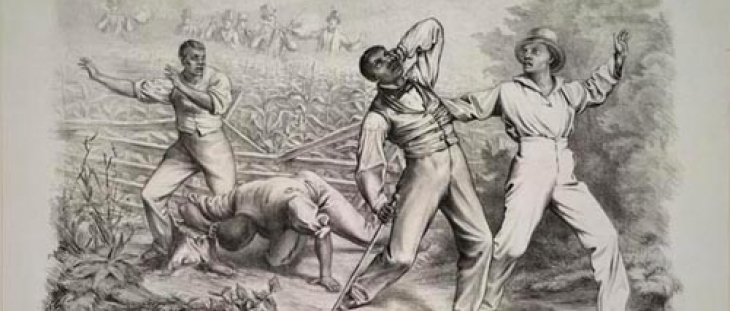
 No Canadian legislature actually abolished slavery. As with all British Imperial society, the institution of slavery came part and parcel with colonialism to Canada. Throughout the eighteenth and early nineteenth century merchants and farmers relied on black slaves to tend to the land and ferry goods about the province. Joseph Brant, the Mohawk military leader who aligned with the British during the American War of Independence, owned more than forty slaves. The Canadian climate, however, ensured that no equivalent to the plantation system developed. Whereas in the American South year-round farming was possible, the northern winter meant that it was cheaper for farmers to employ free labourers during the summer months and lay them off during the winter than it was to pay for a slave’s keep. Because slaves were not entirely integrated into the Canadian economy, abolitionists were able to move with a bit more speed and a bit more latitude than their comrades in the United States. In 1793 the Upper Canadian legislature passed the Slave Act: a law which freed no slaves but did outlaw their import, and said that if a slave gave birth to a child it would have to be freed on its 25th birthday. It was not until 1834, when the Imperial legislature outlawed slavery, that the institution disappeared and the last Canadian slave was freed. White resentment, however, was palpable. There were, to be sure, a number of committed white abolitionists in Upper Canada and Toronto who were pleased that chattel slavery had been vanquished but many went out of their way to make sure that their black fellow citizens didn’t get an easy go of it. Peter Gallego wrote that on a tour of the province he had been assaulted in taverns and steamships, denied passage on stagecoaches, forced to vacate inns and, finally, been imprisoned and fined after being beaten by a crowd of white individuals when the judge presumed that they had somehow been provoked by the presence of a black individual. He referenced a case where a white mob in St. Catherines fell upon–and killed–a black man rumoured to be engaged in a sexual relationship with a white woman. Later, the same mob killed a white man in “a more savage and fiendish manner” for speaking to the authorities. These were not isolated cases. Yet black Canadians were not cowed and throughout the 1830s engaged in serious and seriously productive activism. Organizing themselves into societies, many black individuals sought to criminalize the use of racial epithets (though the white members of the legislature sneered at, and openly made fun of, the proposal). In different regions throughout the province autonomous black communities were developed, with their own schools and churches. But most significant, in terms of black activism, were the efforts to thwart slave catchers. Even some of the most enlightened white abolitionists at the time thought it wrong to encourage slaves to escape. The law, no matter how unjust, should be respected they often said. In one famous case, the Lieutenant Governor sanctioned the extradition of a self-emancipated slave back to the United States on the grounds that, to effect his escape, he had stolen a horse. Slavery may be wrong, but horse-thieving was beyond the pale. In cases like this, black residents of Upper Canada would put their bodies between the law and ex-slaves. In one case, in Niagara, they laid siege to a prison for days, repelling attacks by the military, until the prisoner was able to escape (several people lost their lives in the process). A more common tactic, however, focused on the hotels of international travellers. White Americans from the south often liked to travel with their slaves. Toronto, burgeoning city that it was and gateway to the timber and wheat of Upper Canada, was on occasion frequented by these people on business or, on rare occasion, for pleasure. Local radical abolitionists, black and white, would often, upon learning of the presence of a slaveholder with slaves in the city, threaten the slaveholder’s person or the hotel they were staying in. Their demand: that their slaves be immediately released. The efficacy of the strategy was mixed. Often constables would intervene but, on more than a few occasions, hotels in Toronto or in places like Kingston were burned to the ground. Though Canada, and Upper Canada, became a refuge for escaped slaves, its orientation towards its new black residents was hostile for much of the nineteenth century. __ Simon Wallace writes our Standard Historical Society column each week.
No Canadian legislature actually abolished slavery. As with all British Imperial society, the institution of slavery came part and parcel with colonialism to Canada. Throughout the eighteenth and early nineteenth century merchants and farmers relied on black slaves to tend to the land and ferry goods about the province. Joseph Brant, the Mohawk military leader who aligned with the British during the American War of Independence, owned more than forty slaves. The Canadian climate, however, ensured that no equivalent to the plantation system developed. Whereas in the American South year-round farming was possible, the northern winter meant that it was cheaper for farmers to employ free labourers during the summer months and lay them off during the winter than it was to pay for a slave’s keep. Because slaves were not entirely integrated into the Canadian economy, abolitionists were able to move with a bit more speed and a bit more latitude than their comrades in the United States. In 1793 the Upper Canadian legislature passed the Slave Act: a law which freed no slaves but did outlaw their import, and said that if a slave gave birth to a child it would have to be freed on its 25th birthday. It was not until 1834, when the Imperial legislature outlawed slavery, that the institution disappeared and the last Canadian slave was freed. White resentment, however, was palpable. There were, to be sure, a number of committed white abolitionists in Upper Canada and Toronto who were pleased that chattel slavery had been vanquished but many went out of their way to make sure that their black fellow citizens didn’t get an easy go of it. Peter Gallego wrote that on a tour of the province he had been assaulted in taverns and steamships, denied passage on stagecoaches, forced to vacate inns and, finally, been imprisoned and fined after being beaten by a crowd of white individuals when the judge presumed that they had somehow been provoked by the presence of a black individual. He referenced a case where a white mob in St. Catherines fell upon–and killed–a black man rumoured to be engaged in a sexual relationship with a white woman. Later, the same mob killed a white man in “a more savage and fiendish manner” for speaking to the authorities. These were not isolated cases. Yet black Canadians were not cowed and throughout the 1830s engaged in serious and seriously productive activism. Organizing themselves into societies, many black individuals sought to criminalize the use of racial epithets (though the white members of the legislature sneered at, and openly made fun of, the proposal). In different regions throughout the province autonomous black communities were developed, with their own schools and churches. But most significant, in terms of black activism, were the efforts to thwart slave catchers. Even some of the most enlightened white abolitionists at the time thought it wrong to encourage slaves to escape. The law, no matter how unjust, should be respected they often said. In one famous case, the Lieutenant Governor sanctioned the extradition of a self-emancipated slave back to the United States on the grounds that, to effect his escape, he had stolen a horse. Slavery may be wrong, but horse-thieving was beyond the pale. In cases like this, black residents of Upper Canada would put their bodies between the law and ex-slaves. In one case, in Niagara, they laid siege to a prison for days, repelling attacks by the military, until the prisoner was able to escape (several people lost their lives in the process). A more common tactic, however, focused on the hotels of international travellers. White Americans from the south often liked to travel with their slaves. Toronto, burgeoning city that it was and gateway to the timber and wheat of Upper Canada, was on occasion frequented by these people on business or, on rare occasion, for pleasure. Local radical abolitionists, black and white, would often, upon learning of the presence of a slaveholder with slaves in the city, threaten the slaveholder’s person or the hotel they were staying in. Their demand: that their slaves be immediately released. The efficacy of the strategy was mixed. Often constables would intervene but, on more than a few occasions, hotels in Toronto or in places like Kingston were burned to the ground. Though Canada, and Upper Canada, became a refuge for escaped slaves, its orientation towards its new black residents was hostile for much of the nineteenth century. __ Simon Wallace writes our Standard Historical Society column each week.














